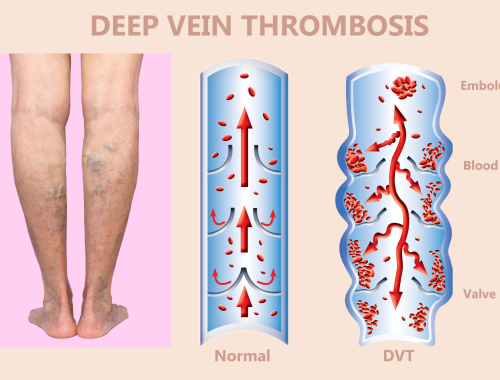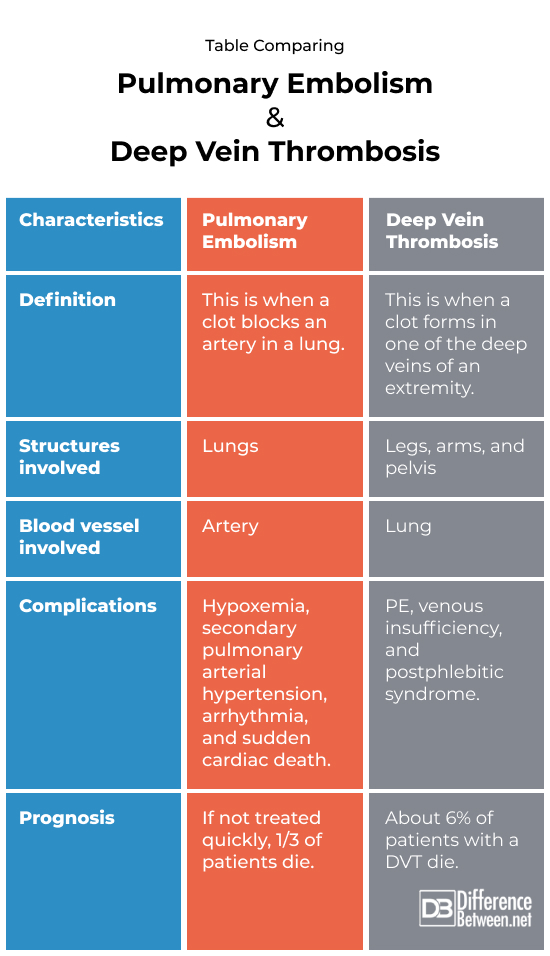Difference Between Pulmonary Embolism and Deep Vein Thrombosis
A pulmonary embolism is when a clot of tissue moves and lodges inside of an artery in the lungs. A deep vein thrombosis is when there is a clot in one of the deep veins, usually in one of the legs.

What is Pulmonary embolism?
Definition:
A pulmonary embolism (PE) is a clot of cells or tissue that has traveled to the lungs and lodged inside an artery.
Causes and prevalence:
The most common cause of PE is a blood clot that was formed as a DVT, which broke loose and traveled to the lungs. However, there are other causes of PE including a fat embolus, air bubble, or even an amniotic fluid embolus. PE occurs in about 0.6 per 1000 people.
Symptoms and complications:
Symptoms of PE include shortness of breath, chest pain, and coughing. Complications of PE include hypoxemia, secondary pulmonary arterial hypertension, arrhythmia, and sudden cardiac death.
Diagnosis:
Pulse oximetry may show low oxygen levels and chest X-rays may show pleural effusions but are not specific to PE. The imaging technique, computed tomographic angiography (CTPA) is the best way to diagnose PE in a patient.
Treatment:
Supportive therapy is done using oxygen and sometimes IV infusions of saline. Anticoagulant medication is often used to help break up the clot in patients who are not at too high a risk. High-risk patients are treated with a combined approach of anticoagulants, thrombolytics, and surgical intervention or by using a catheter to break up the clot. Patients with PE should be hospitalized for 2 to 4 days.

What is Deep vein thrombosis?
Definition:
A deep vein thrombosis (DVT) is when a clot has formed and lodged in a vein in an extremity, such as an arm or leg, or the pelvis.
Causes and prevalence:
Causes of DVT include obesity and being sedentary (including air travel where you may be seated for a long time). You can develop DVT from being in bed for too long, and from certain medical conditions such as polycythemia vera. Some people are also at higher risk of DVT if they have a family history of clots. PE occurs in about 0.8 of every 1000 people.
Symptoms and complications:
Pain in the affected limb, swelling, and redness are possible signs of a DVT. The main complication is that a DVT can lead to PE or chronic venous insufficiency. The venous insufficiency can result in postphlebitic syndrome.
Diagnosis:
Diagnosis of a DVT today is by Doppler flow studies or an ultrasound. In the past, the diagnosis was by contrast venography but today ultrasound can show the veins.
Treatment:
Treatment is often by using anticoagulant medications. A superior vena cava filter can be surgically placed to prevent any clots from moving to the lungs. Thrombolytic drugs are also an option; sometimes, surgical intervention is needed.
Difference between Pulmonary embolism and Deep vein thrombosis?
Definition
A pulmonary embolism is when a clot blocks an artery in a lung. A deep vein thrombosis is when a clot forms in one of the deep veins.
Structures involved
PE occurs in the lung. A DVT occurs in a leg, arm, or pelvis.
Blood vessel involved
PE is a clot in an artery. A DVT is a clot in a vein.
Complications
The complications of PE include the following: hypoxemia, secondary pulmonary arterial hypertension, cardiac arrhythmia, and sudden cardiac death. Complications of a DVT include the following conditions: PE, venous insufficiency, and postphlebitic syndrome.
Prognosis
In the case of PE, 1/3 of patients will die if they do not receive treatment. In the case of a DVT, approximately 6% of patients die.
Table comparing Pulmonary embolism and Deep vein thrombosis

Summary of Pulmonary embolism and Deep vein thrombosis
- A DVT can often result in a pulmonary embolism.
- A pulmonary embolism can be deadly as it blocks an artery in a lung.
- Anticoagulants are often used to treat both a DVT and PE.
FAQ
What is the difference between thrombus and embolism?
A thrombus is the name given to a clot that is generated in a vein. An embolism is a name for a clot that has moved from where it was first formed.
Can you have PE but not a DVT?
Yes, there are cases where PE is not caused by a DVT, but rather something else such as a fat embolus or air bubbles.
Is pulmonary embolism always from DVT?
No, some of the time the embolus is not always a clot of blood but is sometimes a fat embolus or an air embolus.
What are the three types of embolisms?
The three types of embolism are an air embolus, fat embolus, and blood clot embolus (thromboembolism).
Is pulmonary embolism a type of thrombosis?
If it is a blood clot, it often starts as a thrombosis and then travels to the lungs.
Can you have a pulmonary embolism for months without knowing?
It is possible to have PE for a while before knowing because some emboli are small.
What is the best diagnostic test for pulmonary embolism?
The best test for PE is a computed tomographic angiography.
Where is the pain located with pulmonary embolism?
A pulmonary embolism is in the lungs so the person experiences chest pain.
- Difference Between Rumination and Regurgitation - June 13, 2024
- Difference Between Pyelectasis and Hydronephrosis - June 4, 2024
- Difference Between Cellulitis and Erysipelas - June 1, 2024
Search DifferenceBetween.net :
Leave a Response
References :
[0]Becattini, Cecilia, et al. "Risk stratification of patients with acute symptomatic pulmonary embolism based on presence or absence of lower extremity DVT: systematic review and meta-analysis." Chest 149.1 (2016): 192-200.
[1]Douketis, James D. “Deep Vein Thrombosis (DVT)”. Merckmanuals. Merck & Co., 2022, https://www.msdmanuals.com/professional/cardiovascular-disorders/peripheral-venous-disorders/deep-venous-thrombosis-dvt
[2]Tapson, Victor F. “Pulmonary Embolism (PE)”. Merckmanuals. Merck & Co., 2022, https://www.msdmanuals.com/professional/pulmonary-disorders/pulmonary-embolism-pe/pulmonary-embolism-pe
